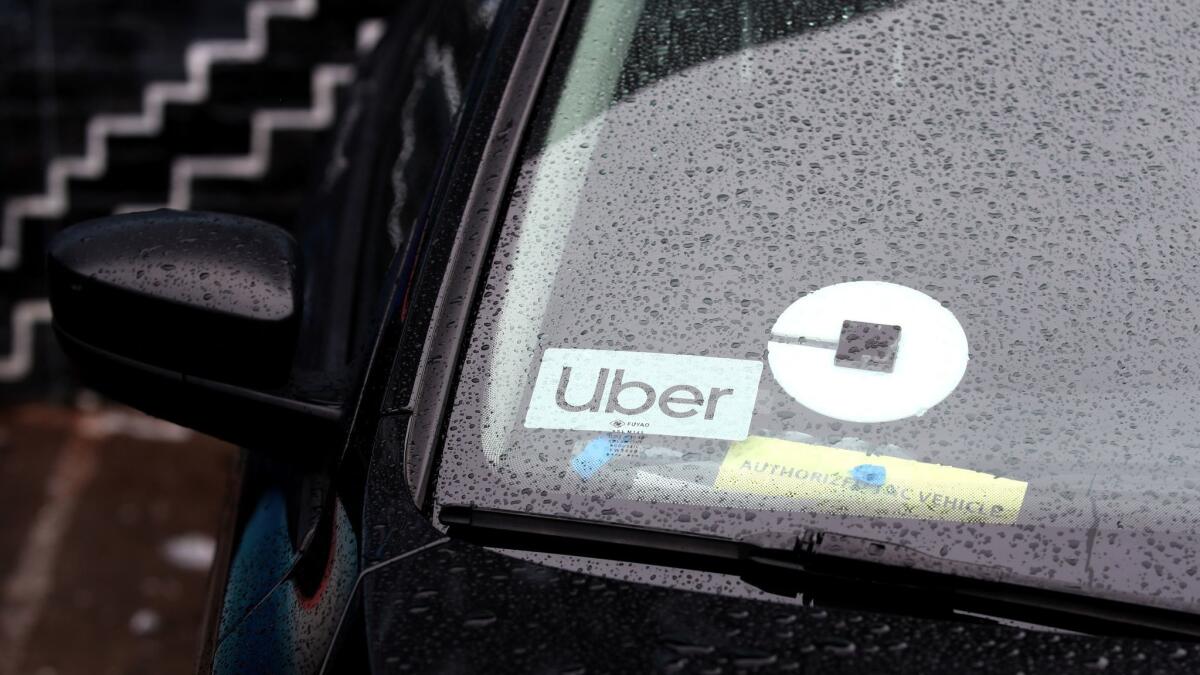Uber is said to seek about $10 billion in year’s biggest IPO

- Share via
Investors could get their first look at hundreds of pages of detailed information about Uber Technologies Inc. as soon as Thursday, as the ride-hailing giant gears up to publicly file for an initial public offering.
The company will kick off a road show to market shares to potential investors this month and would begin trading publicly in May, said people familiar with the matter, who asked not to be identified because the information is private. Uber is seeking to raise about $10 billion, one of the people said.
The offering is expected to be the largest U.S. IPO this year and among the 10 largest of all-time.
While Uber has released partial financial results for years, its IPO filing with the U.S. Securities and Exchange Commission will provide the first complete look at its numbers and operations. Prospective investors are hungry for the minutiae, and they’re now armed with ride-hailing rival Lyft Inc.’s March listing as a reference point for picking apart Uber’s business and value.
“The main thing is going to be the ride-sharing metrics versus Lyft,” said Wedbush Securities analyst Daniel Ives. “I think in the view of many investors Lyft is the little brother to Uber.”
Uber said in February that it generated $50 billion in gross bookings last year, up about 45% from 2017. But the figures show slowing growth. Of the $11.4 billion of net revenue in 2018, only $3 billion came in the last three months of the year, up only 2% from the previous quarter. While that number gave the San Francisco-based company a year-over-year quarterly growth rate of 25% — high by most standards — it fell well short of the 38% rate for the third quarter.
Investors will want an explanation for Uber’s flattening trajectory, a possible signal that its core ride-hailing business may be stalling. They’ll also want to know where the money is coming from as the company expands into food and freight delivery and scooters and bicycles, as it also eyes driverless and even flying vehicles.
Breaking out Uber’s U.S. ride-hailing business from its global operations will be a particular focus for those parsing its IPO to compare it with Lyft, which operates in the U.S. and Canada. A key point of inquiry will be whether Uber has already saturated the U.S. market.
“I don’t know if they’re going to give us enough to get to that level of specificity, but the U.S. is the oldest, most mature market,” said Tom White, a senior analyst at D.A. Davidson & Co. “I think some investors think it has slowed significantly.”
The ride-hailing business is years ahead of food delivery, so prospective investors will probably be less forgiving of losses in the former than the latter.
Contribution margins, a measure that’s meant to show which businesses can operate profitably, will be one tool provided for digging through its spreadsheets. Uber calculates its contribution margin by tacking on more costs than Lyft does, according to people with knowledge of the matter. Uber’s more conservative metric may give investors a better sense of its business, even if it makes direct comparisons with Lyft more difficult.
How the company defines active users will be critical. Lyft counts each person who took “at least one ride on our multi-modal platform through the Lyft app during a quarter” for a total of 18.6 million active riders in the fourth quarter. With its more global and diversified business, Uber’s active-user calculation could be more complicated.
Lyft shares jumped in their debut, but fell below the $72-a-share offer price and closed at $67.44 Tuesday.
Uber was last valued at $76 billion on the private markets when Toyota Motor Corp. invested in 2018. Last year, bankers jockeying to lead the offering told Uber it could be valued at as much as $120 billion in an IPO.
More to Read
Inside the business of entertainment
The Wide Shot brings you news, analysis and insights on everything from streaming wars to production — and what it all means for the future.
You may occasionally receive promotional content from the Los Angeles Times.









